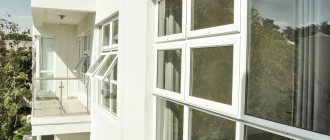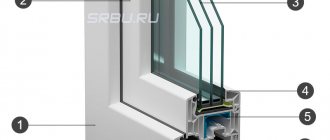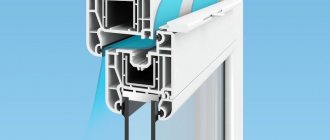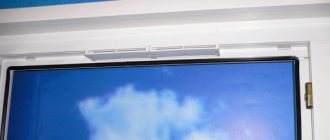A plastic window is a complex structure consisting of a frame, double-glazed windows, fittings and additional elements. Most often, products are assembled to order from ready-made parts produced by other manufacturers; it is extremely rare that companies can offer a full production cycle from the production of profiles and fittings to welding and installation. Therefore, windows from the same profile can be equipped with different fittings and double-glazed windows.
This greatly complicates the choice for the buyer. Finding a good profile system is not enough to get an excellent quality structure. In addition, it is important how the product will be installed and completed. To choose the right plastic windows, you need to understand all the features of these structures.
Selecting a profile system
The base of the window is assembled from a molded polyvinyl chloride profile. This frame bears the main load and serves as a housing for double-glazed windows.
The PVC profile is resistant to mechanical damage, moisture, and atmospheric conditions, has an attractive appearance, is safe for humans and the environment, and is easy to maintain.
Important! Contrary to popular belief, PVC does not emit harmful substances; children's toys and dishes are made from this material. Polyvinyl chloride is only dangerous when burning.
The plastic profile has a rectangular cross-section, inside it there is a cavity with several partitions. Metal reinforcement is inserted into the largest hole. External chambers are equipped with holes for condensate drainage. Air gaps provide high-quality sound and heat insulation and the relative lightness of the finished product.
When assembling a window, different types of main and auxiliary profiles are used: for the frame, sash, impost. And also a glazing bead.
Number of cameras
The profile is classified by the number of air cavities or chambers. There can be from 3 to 8. The most common are 3, 5 and 6-chamber structures; they are suitable for glazing residential premises in all climatic zones of Russia. The rest are used in special operating conditions.
The more chambers in the window structure, the higher its insulating properties. Traditionally, three-chamber ones are used for glazing balconies, loggias, verandas, country houses and residential premises with thick walls. Five-chamber and six-chamber ones are suitable for any residential premises and “warm” balconies.
The width of the profile depends on the number of cameras. The minimum value is 50 mm, the maximum is 130 mm. The most commonly used are 58 mm (3-chamber) and 70 mm (5-chamber). Wider profile systems are used for glazing of houses located near objects with high noise levels and in harsh climatic conditions.
The width of the profile directly affects the depth of the installation seam. If the house has thin walls, you should give preference to profile systems from 70 mm.
Imposts are used as a divider in large openings. They help distribute the load and crush the glass unit.
When choosing a profile, it is important to remember that the greater the number of chambers, the heavier the structure. This can be significant when there is a large area of glazing and installation of frames on a balcony with a weakened slab.
Partition thickness
The thickness of plastic partitions is another important indicator of profile quality. According to GOST 30673-2013, systems are divided into classes:
- A - external walls from 3 mm; internal from 2.5 mm.
- B - external walls from 2.5 mm; internal from 2 mm.
- C - all other types of profiles, the wall thickness of which is less than that of class B.
The wall thickness affects the dimensional stability, strength and insulating properties of the profile system. It is impossible to measure partitions on a finished product, so you need to clarify the profile class and ask for a sample before choosing a system.
For glazing residential premises, it is recommended to use class A profile. For non-residential premises, B is suitable. C can only be used on objects where there are no requirements for the quality of the profile - these are outbuildings, garages, gazebos.
Profile appearance
The classic version of the profile appearance for plastic windows is a white glossy surface. But sometimes it does not fit into the exterior of the building or is not suitable for the interior. Then they resort to various methods of decoration:
- Lamination - application of film. To ensure that the coating holds tightly, use glue and heat the surface of the plastic. The film imitates the structure and shades of natural wood. This decoration method is the most common. Allows you to use different shades of lamination for the outer and inner sides of the window.
Laminated PVC profile. - Body coloring is the addition of pigment during the profile production process. The method allows you to give the surface a uniform, monochromatic color.
Coloring plastic in bulk. - Co-extrusion is the application of a thin layer of acrylic, which is combined with plastic into a single whole. The method is expensive, but such a surface is resistant to any external influences.
A thin layer of acrylic on a PVC surface. - Painting - application of powder paint. Allows you to give the profile any color. You can combine different shades in one product.
Powder coating.
All methods of decoration increase the cost of the product, but improve its appearance and expand the possibilities for designers. In addition, many types of finishes increase the resistance of PVC to atmospheric conditions.
Manufacturers of PVC profiles
Profiles of domestic and foreign brands are presented on the Russian market, and they are equally widespread and well-known. To ensure that the products of foreign companies can compete on price with local manufacturers, almost all companies have opened factories in Russia.
KBE
The products of the German company have been presented on the domestic market since 1995. Today there are two factories operating in Russia. They produce products that strictly comply with German standards. The company's engineers participated in the development of GOST standards for PVC windows.
The range of factories includes profile systems from 3 to 7 chambers with an installation depth from 58 to 88 mm.
The main product qualities for KBE are environmental friendliness, energy efficiency and reliability. The profile is produced using greenline technology, which eliminates the use of dangerous lead in production.
Rehau
Products of a Swiss company. One of the most famous brands in the world. Manufacturers rely on the high insulating characteristics of profiles. Therefore, they are perfect for the harsh Russian winter. Manufacturers guarantee operation of the profile without loss of insulating properties for at least 50 years.
Distinctive features of Rehau profile systems are impeccable surface smoothness, high thermal insulation properties, stylish design with soft lines.
Veka
Veka profile systems are presented all over the world. Their production is also open in three cities of Russia. The brand has its own research center, which is engaged in product improvement.
The company's product range includes a wide selection of systems that solve specific problems and are used in certain conditions. The company offers profiles for sound insulation and thermal insulation.
SALAMANDER
The company was formed as a result of the merger of SALAMANDER and BRÜGMANN. The profile is produced in Russia and other countries of the world using German equipment.
The manufacturer offers 5, 6 and 7-chamber systems, with installation depths up to 92 mm. Produces class A and B profiles with two and three sealing circuits.
The brand features are environmentally friendly products, energy efficiency and long service life.
Brusbox
A domestic company with a long history. It has existed since 2004. It has dealership centers throughout Russia and other countries.
Produces profiles that fully meet Russian operating conditions. When releasing products, it uses its own research and experience.
Produces 3, 4, 5, 6-chamber profile systems. With installation depth up to 70 mm.
MONTBLANC
Russian manufacturer of profile systems for windows. Manufactures products using Austrian equipment. The profiles are of good quality and low price.
Produces three- and five-chamber profiles, class A. Claimed durability is up to 60 years.
Novotex
The profile system is produced in Russia. It produces 3, 5 and 6-chamber class A profiles. It does not use lead in production, which makes the windows safe not only during operation, but also during production. The company uses extrusion equipment from European manufacturers.
Novotex offers systems with two and three sealing circuits. The main qualities of profiles are practicality, excellent insulation, attractive appearance, low cost of finished products.
Design features of glazing
The frame of a PVC window is a profile. Many have heard that it can be two-, three-, six-chamber... The chamberness in this case refers specifically to the plastic frame, and not to its glass filling - double-glazed windows. As a rule, a glass bag has 1-3 chambers. When answering the question of how many cameras there should be in a plastic window, you need to correctly understand what a camera is. This is a profile cavity limited by its wall. It insulates heat and noise. Therefore, the more chambers the plastic has, the warmer and “quieter” it is.
Selecting a double-glazed window
A double-glazed window is a structure of two or more glasses fastened together through a spacer frame. The space formed between the glasses is called chambers. They are filled with dried air or inert gases - argon, krypton. Gas-filled breaks improve the insulating properties of glass. Air is the cheapest filler. Inert gases are more expensive, but significantly improve the thermal insulation properties of the structure.
Number of cameras
Double-glazed windows can have a width from 14 to 44 mm and from 1 to 3 chambers:
- Single-chamber double-glazed glass is suitable for glazing unheated rooms - verandas, balconies, loggias, country houses.
- Double-chamber, three-glazed glass is used in heated rooms - apartments, private houses, offices.
- Three-chamber, four-glass windows are designed for use in harsh climatic conditions, where the air temperature often drops below -30°C.
Different types of glass are used in double-glazed windows: energy-saving, multifunctional, tinted, sun-protective, armored, soundproof.
Read more about double-glazed windows here.
Decoration of double-glazed windows
Double-glazed windows take up most of the glazing, so their appearance plays an important role. To make the designs look unusual, different types of decor are used:
- Shpros are thin slats, usually silver, gold or white. They are placed inside the glass unit, forming patterns. Complex parts are made from ready-made elements.
- False bindings are plastic slats that visually break the glass unit into several parts. They are located inside or outside the glass unit.
- Tinting is a film that reflects or dims light. It gives the glass any shade, protects it from sunlight and hides residents from the eyes of passers-by.
Decoration methods can be combined. They allow you to emphasize the status of the owner of the room and give a unique design to the window opening.
Tinted double-glazed window with interlocking bars.
What types of plastic windows are there?
In addition to the width of the products and the thickness of their walls, the profiles used in the manufacture of PVC windows are also classified by the number of chambers and the presence of reinforcement. Each of these parameters is described in detail below.
By number of cameras
Based on the number of internal closed chambers, there are 6 types of plastic profiles for window units.
- Single-chamber . They are used extremely rarely, since such structures not only do not satisfy the thermal characteristics, but also do not provide the necessary strength. They are used when installing blind windows in sheds, storage rooms and other utility rooms.
- Two-chamber . The cross section of such a profile is divided by a plastic partition approximately in the center of its width. The windows are suitable for installation in boiler rooms, basements or attics. As a rule, they are supplied for the installation of single-chamber double-glazed windows or single glazing.
- Three-chamber . Standard economy class designs. Provide resistance to heat transfer at outdoor temperatures down to – 10 °C. Most often, they are used for glazing residential buildings and apartments in the southern regions of our country.
- Four-chamber . The products belong to the middle price category and are installed in the central zone of the Russian Federation. 4 closed spaces provide sufficient structural strength for the manufacture of windows with dimensions of more than 1500 x 1500 mm, as well as balcony doors. Often, 4-chamber windows are used by developers when glazing residential areas under construction as part of the implementation of a development program.
- Five-chamber . The most popular elements for window units, which are ordered by consumers individually. 5 closed chambers are optimal for operation in areas with the coldest five-day temperature - 28 ° C.
- Six-chamber . Exclusive products with a thickness of 90 mm. 6-chamber frames are characterized by impeccable energy efficiency and high retail price. They are mounted on the upper floors of high-rise buildings, and are also used as structural elements for reinforced panoramic windows.
If it is necessary to replace windows in an apartment, experts recommend giving preference to 4 and 5 chamber profiles. In the case of equipping unused spaces that do not have strict thermal requirements, it is sufficient to use 1-3 chamber structures.
When purchasing a profile for a window frame, you should not confuse the number of chambers with the number of enclosed spaces in a double-glazed window, which ranges from 0 to 2, depending on the number of glasses in a single block (from 1 to 3).
By the presence and form of reinforcement
PVC products used for window structures must meet strength conditions, which is especially important when installing translucent structures on upper floors, or when the product area is large. In such cases, manufacturers provide several types of profile design:
Non-reinforced – structures that do not have increased strength requirements.
They are used for the manufacture of windows with dimensions up to 1.8 x 1.5 m, which are installed in buildings that are not exposed to the pulsating component of wind load.- With reinforcement from a U-shaped profile - standard window structures that are widely offered by manufacturing companies to fill standard openings in apartment or individual buildings, as well as in offices and small shopping centers.
- With square pipe reinforcement - reinforced profiles that can be mounted on sites with increased requirements for the strength of the window frame.
- With reinforcement from carbon plates - expensive products of a higher price category, inside of which rigid plates made of aramid fibers are installed. They are distinguished by impeccable thermal characteristics, without reducing strength.
When choosing a profile with reinforcement, the consumer should take into account that such a product must consist of at least 4 - 5 chambers in order to prevent the formation of a cold bridge.
Selection of accessories
The hardware is the window sash mechanism. She is responsible for the functioning of the structure. The fittings include trim on three sides of the sash, scissors, strikers, latches, hinges, pins and a handle.
The service life of the window and the ease of use of the opening sashes largely depend on the quality of the fittings. You cannot save on this part of the design. There is little price difference between different brands. Therefore, it is worth paying more once and minimizing adjustments and breakdowns.
The fittings are made of steel. The surface of the elements must be protected from corrosion. Decorative overlays for visible parts of the mechanism can be made from plastic. The handle can also be made of PVC, but it is better to choose a metal one - it is stronger and more durable.
It is difficult for the average person to understand the difference between fittings from different brands, so it is worth giving preference to proven brands:
- Siegenia aubi - products of a German company, are of high quality, suitable for standard sashes and those with complex geometries. Adjustment for winter and summer pressure is possible. A stepped ventilation system has been installed. There is slot micro-ventilation. Reliably protects against burglary and ensures smooth movement of the sash.
- Roto - German fittings. The company produces a huge range of mechanisms for windows and doors. The range of functions depends on the model. There is adjustment for winter and summer mode.
- MACO is an Austrian brand product. The fittings ensure security against burglary. When developing mechanisms, manufacturers rely on the absence of unnecessary things and the inconspicuousness of the device - this makes windows equipped with MASO fittings elegant and neat.
Experts recommend choosing especially carefully the fittings for a large sash; the mechanism must support its weight, otherwise sagging cannot be avoided.
Tips for choosing accessories:
- For the first floors and private houses, it is better to use anti-burglary fittings.
- For children's institutions, the installation of any blockers is mandatory; these can be cables or locks or removable handles. These same devices are recommended for use in apartments where small children live.
- The standard set of accessories often includes a budget plastic handle; it is better to immediately replace it with a metal one.
- Ask the seller for product certificates. High-quality fittings can withstand 50-60 thousand opening and closing cycles and last at least 10 years.
- Well-known manufacturers put their own logo on the fittings - this is protection against counterfeiting.
PVC window blocker.
In order for the fittings to serve as long as possible, it is necessary to clean them from dust once a year and lubricate the moving mechanisms with special oil. It can be purchased at a hardware store, hardware store, or from window manufacturers.
Important! Even the most expensive and reliable fittings need periodic adjustment. If the sash is sagging, you need to call a specialist as soon as possible and adjust the mechanism. Continued use of such a sash can lead to serious damage.
Reinforcing insert: what to look for
PVC windows are often called metal-plastic. A steel reinforcing insert must be installed in each frame and sash in accordance with GOST 30674-99.
Its absence is a direct violation of the standard. You can check the presence of reinforcement in the finished product using a strong magnet.
The reinforcing insert is a U-shaped, square or L-shaped steel liner. The thickness of its walls should be at least 1.2 mm. The surface is treated with an anti-corrosion coating.
The liner prevents profile deformation during heating and cooling. Without it, the structure quickly changes geometry and loses its tightness.
It is impossible to check the quality of the reinforcing insert in the finished window. An unscrupulous manufacturer may insert the reinforcement in separate fragments or use thin metal or metal that is not protected from corrosion. But the most irresponsible manufacturers do not use a metal insert at all.
How to distinguish from three-chamber
A 5-chamber window is a complex structure with metal reinforcement inside. Along the perimeter of the structure there is a steel profile (skeleton), which allows it to withstand the weight of several compartments and glass. All parts are located parallel and fixed with special frames.
To form five inserts, 6 glasses are needed. Visually, the equipment looks impressive and powerful. The structural features keep you warm in cold weather and cool in hot weather. The differences between the designs are clearly visible in the cross-section. The 5-section structure is 1 cm thicker than the 3-compartment options.
Features of different profiles Source opendoors.kiev.ua
Selecting a seal
Complete tightness of PVC structures is achieved through sealing contours. Under normal operating conditions, two are enough - one on the sash and one on the frame. To improve sound and heat insulation properties, some profile systems are equipped with an additional circuit. Seals are also located around the perimeter of the glass unit on both sides.
The seals on the frame and sash are subject to accelerated wear, as they are compressed and regain their shape when opening and closing. The seal is broken when the contour is no longer able to compress freely and return to its original shape.
The seal is an elastic cord that is installed in a special groove on the profile. It also has air chambers, which allow it to change shape and reliably close the gap between the frame and the sash.
Seals are made from various materials:
- Rubber is the most common and inexpensive option. It does its job well, but after 5-7 years of use it loses its elasticity, cracks and collapses. It hardens a lot in the cold.
- Silicone is an expensive material, but it retains its properties in all weather conditions and is less susceptible to destruction than rubber.
- EPDM is a sealant made of ethylene propylene rubber. Resistant to weather conditions. It has a reasonable price. Serves for about 15 years.
- TPE - thermoplastic elastomer seal. Just like rubber, it hardens in the cold and softens greatly in the heat. Available in various colors, welded in corner joints. Has no smell.
In fact, the choice of seals for PVC windows is not as wide as it seems at first glance. In most cases, the manufacturer installs only one type, without giving the buyer the right to choose. It is also not always possible to replace one seal with another on your own; the installation groove may not be suitable for a cord of a different shape and material.
Which profiles are best suited for cottages
In private cottages, heat loss is traditionally higher than in apartment buildings, so it is recommended to pay special attention to the issue of energy efficiency. To do this, you also need to choose window profiles that, during operation, will ensure minimal heat leakage and will not serve as cold bridges. In this capacity, it is most rational to use systems with 6-8 internal chambers. This approach allows you to significantly reduce heating costs for private households.
Number of doors and opening method
PVC structures can be solid or with opening doors. The first ones are suitable for rooms with several windows, some of which are equipped with opening mechanisms. For large windows, the number of functional sashes is important - there should be enough of them for normal ventilation and maintenance of double-glazed windows from the outside. For large glazing areas, for example, on balconies and loggias, opening doors are installed every 1-1.5 meters.
Types of opening mechanisms for sashes:
- Pivot - a classic option that allows you to open the sash, like on a regular wooden window.
- Swivel and tilt are more functional designs. Provide ventilation with different intensity. The folded flap is safe for children.
- Sliding ones are not yet very popular models in Russia. They are used mainly for glazing balconies and loggias, entrance areas.
- Rotating ones are the rarest option. The sash rotates around its axis, which makes it easy to clean the street side of dirt.
The most popular are tilt and turn mechanisms. They are functional, convenient and safe. Suitable for frequent and continuous ventilation of premises. Provide easy access to the outside of the glass unit. They have a reasonable price.
Pros and cons of multi-chamber profiles
Multi-chamber PVC profile for windows retains heat much better and is less susceptible to deformation. Products with 3 internal compartments are significantly inferior in this regard to other modifications, so they are usually used in warehouses, workshops and workshops, as well as other facilities where there are no special requirements for comfort. Among the disadvantages of multi-chamber profiles, it is worth highlighting:
- weight gain;
- slight reduction in the light opening of the window.
These disadvantages cannot be considered critical, since they do not have a significant impact on the performance characteristics of the windows. And the higher cost of such products is a completely objective factor due to production costs.
How long do PVC windows last?
The service life of a window depends on the quality of all structural elements: profile, double-glazed windows, seals, fittings. Last but not least, assembly and installation are important. Typically, manufacturers provide a guarantee for a period of 5 to 10 years, but the actual duration of use of structures is much longer - several decades.
The profile lasts the longest - 50-60 years. All other elements - up to 10-15 years, subject to operating rules and regular maintenance. But double-glazed windows, fittings and seals can be repaired and replaced.
To extend the service life it is necessary:
- Troubleshoot the opening mechanism in a timely manner.
- At least once a year, clean the moving parts of the fittings from dirt and lubricate them.
- Clean the drainage holes and seal from dust twice a year.
- In spring and autumn, lubricate the seal to protect it from moisture and sun.
For professional and high-quality window care, you can purchase a special kit, which includes lubricant for fittings and seals and a soft cloth for cleaning dust.











